Rustic wonderland with class and comfort
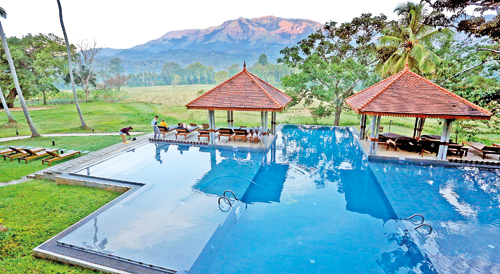
Kaduruketha: Agro-eco tourism at its best. Pix by M.A. Pushpa Kumara
Passing a 1953 Ferguson TE20, the second oldest tractor brought to the area, we enter a walauwwa to be served with a ‘saravita’ cone of betel leaf brimming with shredded coconut in red, green and orange, spiced with arecanut, nutmeg, cardamom, mace, coriander seeds, cumin, golden syrup and jaggery.
Then with a glass of raw mango juice to perk up the weary body after a long journey, a few steps out of the walauwwa-cum-reception open up a vista of agri-eco natural wonder that takes the breath away and brings peace and serenity.
As far as the eye can see, sprawl fields where the golden-sheaves of paddy have been harvested, bringing to mind what the expanse would look like when the slender green plants sway in a light breeze or the golden ears of paddy gaze up for showers of rain, depending on the time of year.
From the moment a visitor steps into Jetwing ‘Kaduruketha’ in rustic Wellawaya, there is a wonderland not commonly experienced elsewhere around the country – agro-eco tourism with a lavish touch of class and comfort. The architecture and theme are Kandyan, proudly depicting the red, yellow and black of that era.
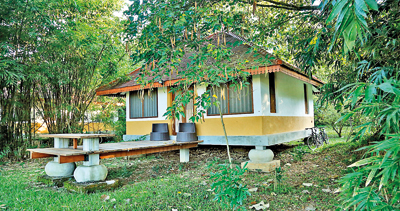
Kandyan architecture to the fore
Having checked us in, a personal butler leads the way to cozy chalets ‘Vel Vidana’ and ‘Arachchi’, as Kaduruketha set amidst 60 acres of land fringed by the Kirindi Oya, reveals its beauty. We arrived as the sun set across the Poonagala mountain range and were serenaded by the distinctive calls of peacocks.
Be it early morn, noon or twilight even though numerous are the birds that fly past or small mammals that slink by, Kaduruketha’s mascot seems to be the peacock.
An interesting feature is that even though Wellawaya is in the Moneragala district, Kaduruketha is in the intermediate and not dry zone, with lush foliage and high biodiversity.
The Vel Vidana chalet is an eye-opener, for from the king-size bed, the view is directly of the wel-yaya with a thick green belt of trees acting as a secluding barrier far away. As the evening shadows lengthen into night, in the distance can be seen farmers, both men and women, wending their way back home.
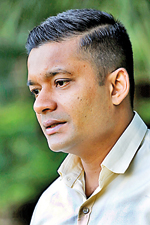
GM Naminda Rathnayake
“We are promoting the agro-nature eco concept,” explains General Manager Naminda Rathnayake pointing out that they encourage the farmers in the village to cultivate 50 acres, with 10 acres accommodating the low-slung buildings including the 25 chalets.
The hotel is in a symbiotic relationship with the farming community as 31 families have the responsibility of cultivating the land organically. Each family is supported with Rs. 40,000 a month and has the option of selling the harvest to the hotel or in the open market.
With justifiable pride, Mr. Rathnayake says that in the Maha season of August 2018 and February 2019, 10 of these acres were used for the cultivation of 25 traditional rice varieties including Pachcha Perumal, Kahavanu and Suwadel yielding an average harvest of 1,200 kilos per acre. The farmers could choose the varieties that they wished to cultivate and no insecticides were used, only organic compost.
The traditional rice cultivations are a pilot project, with the harvest being bought from the farmers for consumption in the Jetwing Group of Hotels and plans to provide for the general market in the near future.
Rural the setting may be of Kaduruketha but all the usual facilities and more are available including a swimming pool inspired from the bathing area of Queen Sugala overlooking the wel-yaya, the restaurant just above the pool serving a wide range of food from the delicious traditional cuisine to western dishes, served by the vegetable and herb gardens of the hotel itself, a soothing spa and a yoga & wellness programme.
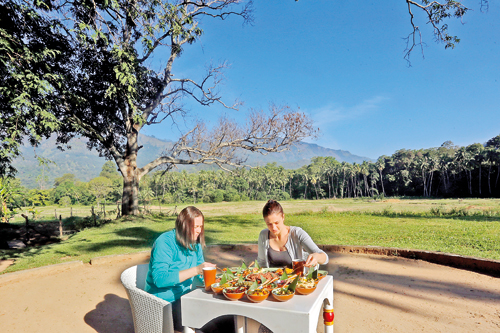
Breakfast amidst vista of sprawling paddy fields
A walk through the village and a farmer’s lunch after trying out cooking game kema; breakfast on the kamatha; or lazing in the cool waters of the Kirindi Oya are some ‘extra-specials’.
Many surprises, meanwhile, await the visitor from within the chalet – from showering under the twinkling stars in an area open to the skies, to relaxing sans air-conditioning or television but with WiFi connecting in an instant and requiring no password.
Even the minutest detail draws inspiration from the environs, no fancy dish but a small rock atop which sits the cake of soap, all toiletries tucked into cloth bags tied with string at the neck, toilet paper not white but yellow made of wheat husk and glass not plastic bottles of water. There are many green practices too at Kaduruketha.
Eighty percent of the 65 staff members are from the area itself, recruited and trained under the Jetwing Youth Development Programme, while most requirements are also bought locally except the meats and some imported items.
As night drops down its mantle on this pastoral scene, ‘deafening’ is the silence enhanced only by the orchestra of the cicadas, tuning up on one side and then another and the sudden shout of ‘Did he do it?’ from a kerala.
Although Kaduruketha could be the hub for many an excursion, who would venture out leaving this rustic beauty behind?
A well-rested night and as we bid goodbye to the staff near the ‘basthama’ tree, which according to folklore keeps wild elephants at bay, the answer echoes the sentiments of many before us: “We don’t want to leave!”
| Architect driven by passion for environment | |
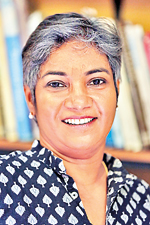 Sunela Jayewardene Environment being her religion, she does not think that she could “build” anything more beautiful than a tree. “Even if you have a single tree, you design around it. You have to frame the tree, for it would be presumptuous of me to think that I could design a building more beautiful than a tree,” reiterates Architect Sunela Jayewardene whose ‘vision’ has made Jetwing Kaduruketha what it is, something out-of-the-ordinary. And the inspiration came as she stood in the walauwwa looking out over the land, long before taking up her drawing board……“I have always found that if you stay within the context of an area geographically and you try to find the vernacular language of that particular geography you can’t go wrong. This is something which has been tried and tested for centuries.” Reconstructing the run-down walauwwa to its original state from a measured drawing she had done, she made add-ons according to the new requirements……..while allowing this feudal home of yore from where feudal landlords managed their lands to guide her concept for Kaduruketha. The design came naturally, with a very clear guideline from Kandyan architecture because that is our last reference point in Sri Lankan architecture and most other reference points are gone, she says. “So architecturally, it stayed within the Kandyan era – the flat terracotta shingles work really well for the Sri Lankan climate because you can take sharp angles as the tile itself has a hook in it and does not slide. It takes the weight of monkeys better than other tiles and has a lot of advantages, allowing the heat to rise up and bringing about passive cooling, making air-conditioning redundant,” says Ms. Jayewardene. Using a Kandyan home garden system, which is sustainable land management, she opted to use part of the property as highland and the balance for the view. “If you put chalets all over, you would have ruined the whole concept.” Focusing on the important role played by the Vel Vidana who was in charge of the village wewa (tank) and took critical decisions when to release or conserve water, she got a clear frame. To design within that was not difficult. She says: “I have very simple principles in design which are using sustainable materials. Being an environmental designer, all that comes naturally. The language is already in place. I won’t draw a line until I see the land. The land is actually what decides what is to grow there in terms of a structure. I see architecture as an organic process that comes out of the land. Having seen the land, I came up with a concept. I used H. Parker’s ‘Village Folk-Tales of Ceylon’ as a guiding principle. It works because there must be some vestigial memory of what Sri Lankans are familiar with. What works on a land and that creates a sense of familiarity.” With her architectural bent being driven by her passion for the environment, she believes she has a very simple principle of design. “I don’t like to impose on the land. I like to frame views rather than try to become the view,” adds Ms. Jayewardene.
|


